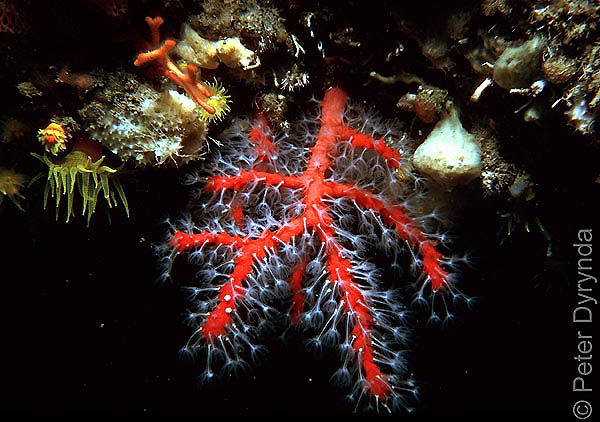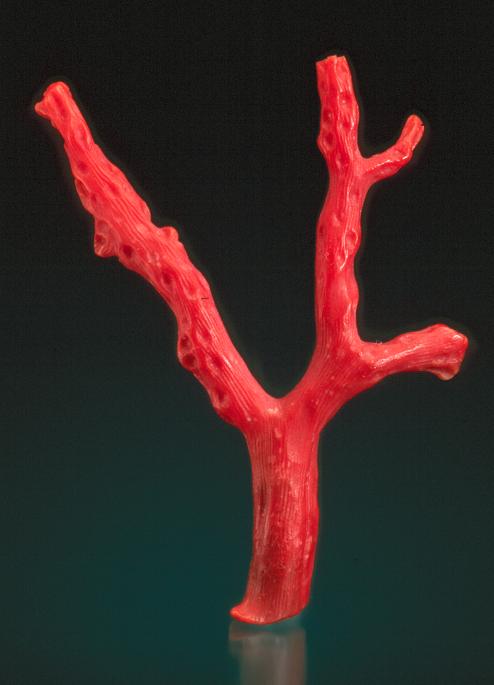CORALS*

A. Coral. Precious coral (Corallium rubrum (Linnaeus, 1758)) in a Mediterranean
cave. (© photo by Peter Dyrynda, from www.solaster.net)

B. Coral. Precious coral (Corallium rubrum (Linnaeus, 1758)) from Italy (height
- 4.9 cm). Ariel. (© photo by
Jeffrey A. Scovil)
C. Coral. Black coral rough.
Genus and species, geographic source, size and other information not
supplied. (© photo furnished by Peter Rohm, Rohm
GmbH
& Co Kg, Linz, Austria)
DESCRIPTION: Phylum Cnidaria
(=Coelenterata), Class Anthozoa: The diversity of corals is
manifest by forms with widely known common names such as
brain corals
(Diploria and Mændrina), organ pipe coral (TubiporaI), precious coral (Corallium) and chain coral (Halysites), which is extinct. In modern
seawater: Skeletons
secreted by
scleractinian corals (the "hard [or stony] corals") consist
chiefly of aragonite; skeletons of some "soft [octo] corals"
are chiefly high-Mg calcite with small amounts of calcium phosphate
[bioapatite?] (Justin Ries, personal communication,
2006); skeletons of antipatharian corals consist of
horn-like proteinaceous
material(s),
variously
recorded as antipathin, chitin, conchiolin, gorgonin and/or
keratin. Although coral
skeletons with each of the just mentioned compositions have been used
in fashioning decorative items, most of the following properties are
for the corals most widely recognized for their
use in jewelry
and/or
decorative pieces -- i.e.,
so-called precious coral and black coral.
Colors - White, red, pink or orangy pink, blood-red, “black" (i.e., intense black to brownish black), and rarely yellow, bluish or violet, with some exhibiting more than one color -- e.g., some chiefly white coral exhibits small, irregular zones that are pink, orange or pinkish orange. "Corallium rubrum [(Linnaeus, 1758)] is pure red with no white spots, while Corallium japonicom[???] and Corallium elatius[Ridley, 1882] ... always have some white in them [Initial upper case letters and italics given on scientific names were not in original article.]. And the difference between these two is that japinicum is shiny like glass, while elatius is dull." (Peter Rohn per Yonick, 2003, p. 8)
Colors - White, red, pink or orangy pink, blood-red, “black" (i.e., intense black to brownish black), and rarely yellow, bluish or violet, with some exhibiting more than one color -- e.g., some chiefly white coral exhibits small, irregular zones that are pink, orange or pinkish orange. "Corallium rubrum [(Linnaeus, 1758)] is pure red with no white spots, while Corallium japonicom[???] and Corallium elatius[Ridley, 1882] ... always have some white in them [Initial upper case letters and italics given on scientific names were not in original article.]. And the difference between these two is that japinicum is shiny like glass, while elatius is dull." (Peter Rohn per Yonick, 2003, p. 8)
H.
2½ - 4:
Red and white coral - 3 - 4, increasing
with Magnesium carbonate content; black coral
- typically 2½ - 3.
S.G. 2.60 - 2.72 for carbonate corals, with 2.65 +.05, recorded for red coral; 1.32-1.4, for black coral.
Light transmission - semitranslucent to opaque
S.G. 2.60 - 2.72 for carbonate corals, with 2.65 +.05, recorded for red coral; 1.32-1.4, for black coral.
Light transmission - semitranslucent to opaque